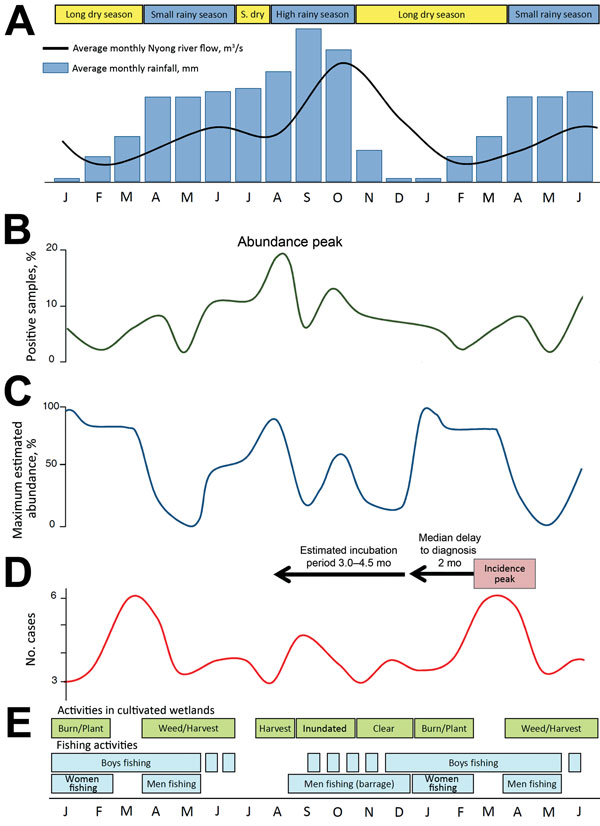Volume 21, Number 8—August 2015
Dispatch
Seasonal Patterns of Buruli Ulcer Incidence, Central Africa, 2002–2012
Figure 2

Figure 2. Schematic representation of the seasonal changes and possible links between the environment, Mycobacterium ulcerans presence, human exposure, and Buruli ulcer (BU) incidence in the Akonolinga district and the Nyong River valley, Cameroon, 2002–2012. For better visualization of delays, 18 months are shown. A) Average monthly rainfall and mean Nyong River flow (Technical Appendix). S, dry, short dry season. B) M. ulcerans prevalencein the aquatic environment (percentage of M. ulcerans–positive samples) (14). C) Estimated abundance of M. ulcerans–positive hemipterans (expressed as % of maximum abundance) (14). D) Monthly median number of BU cases detected in the Akonolinga district, 2002–2012 (this study). E) Selected activities involving contacts with environments in which risk for BU is high (T. Giles-Vernick, pers. comm., 2015).
References
- Merritt RW, Walker ED, Small PLC, Wallace JR, Johnson PDR, Benbow ME, Ecology and transmission of Buruli ulcer disease: a systematic review. PLoS Negl Trop Dis. 2010;4:e911. DOIPubMedGoogle Scholar
- World Health Organization. Summary data. WHO meeting on Buruli ulcer control and research, 2013 Mar 25–27; Geneva; 2012 [cited 2013 Dec 12]. http://www.who.int/buruli/Summary_data_and_new_target_2013.pdf
- Landier J, Gaudart J, Carolan K, Lo Seen D, Guégan J-F, Eyangoh S, Spatio-temporal dynamics and landscape-associated risk of Buruli ulcer in Akonolinga, Cameroon. PLoS Negl Trop Dis. 2014;8:e3123. DOIPubMedGoogle Scholar
- van Ravensway J, Benbow ME, Tsonis AA, Pierce SJ, Campbell LP, Fyfe JAM, Climate and landscape factors associated with Buruli ulcer incidence in Victoria, Australia. PLoS ONE. 2012;7:e51074. DOIPubMedGoogle Scholar
- Marston BJ, Diallo MO, Horsburgh CR, Diomande I, Saki MZ, Kanga JM, Emergence of Buruli ulcer disease in the Daloa region of Côte d’Ivoire. Am J Trop Med Hyg. 1995;52:219–24 .PubMedGoogle Scholar
- Revill WD, Barker DJP. Seasonal distribution of mycobacterial skin ulcers. Br J Prev Soc Med. 1972;26:23–7 .PubMedGoogle Scholar
- Uganda Buruli Group. Epidemiology of Mycobacterium ulcerans infection (Buruli ulcer) at Kinyara, Uganda. Trans R Soc Trop Med Hyg. 1971;65:763–75 . DOIPubMedGoogle Scholar
- Barker DJP, Carswell JW. Mycobacterium ulcerans infection among tse-tse control workers in Uganda. Int J Epidemiol. 1973;2:161–5. DOIPubMedGoogle Scholar
- Cazelles B, Chavez M, De Magny GC, Guégan J-F, Hales S. Time-dependent spectral analysis of epidemiological time-series with wavelets. J R Soc Interface. 2007;4:625–36.PubMedGoogle Scholar
- Trubiano JA, Lavender CJ, Fyfe JA, Bittmann S, Johnson PD. The incubation period of Buruli ulcer (Mycobacterium ulcerans infection). PLoS Negl Trop Dis. 2013;7:e2463. DOIPubMedGoogle Scholar
- Ravisse P. Skin ulcer caused by Mycobacterium ulcerans in Cameroon. I. Clinical, epidemiological and histological study [in French]. Bull Soc Pathol Exot. 1977;70:109–24.PubMedGoogle Scholar
- Morris A, Gozlan RE, Hassani H, Andreou D, Couppié P, Guégan JF. Complex temporal climate signals drive the emergence of human waterborne disease. Emerging Microbes & Infections. 2014;3:e56.
- Pouillot R, Matias G, Wondje CM, Portaels F, Valin N, Ngos F, Risk factors for Buruli ulcer: a case control study in Cameroon. PLoS Negl Trop Dis. 2007;1:e101. DOIPubMedGoogle Scholar
- Garchitorena A, Roche B, Kamgang R, Ossomba J, Babonneau J, Landier J, Mycobacterium ulcerans ecological dynamics and its association with freshwater ecosystems and aquatic communities: results from a 12-month environmental survey in Cameroon. PLoS Negl Trop Dis. 2014;8:e2879. PLoS Negl Trop Dis. 2014;8:e2879 .DOIPubMedGoogle Scholar
- Giles-Vernick T, Owona-Ntsama J, Landier J, Eyangoh S. The puzzle of Buruli ulcer transmission, ethno-ecological history and the end of “love” in the Akonolinga district, Cameroon. Soc Sci Med. 2015;129:20–7. DOIPubMedGoogle Scholar